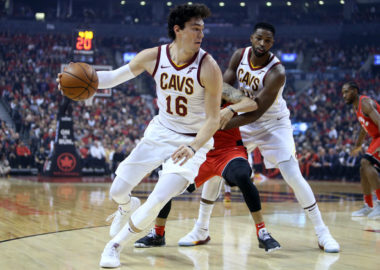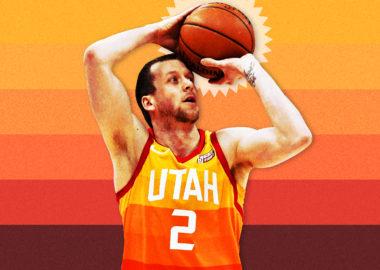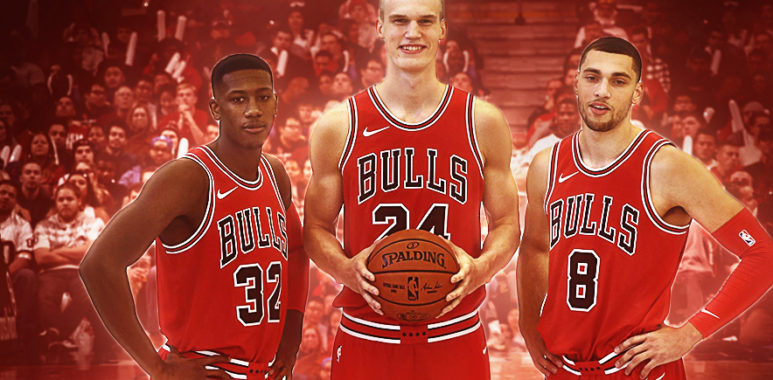
Four Questions for the Chicago Bulls’ Opening Night Roster
The 2018-19 NBA season has arrived, and the Chicago Bulls feel they have the 17 players necessary to tackle what is on the horizon. This roster could be a dark horse pick for the eighth seed in the Eastern Conference playoffs. Before they get there, however, the Bulls need to answer a number of crucial questions at each position.
Point Guard: Can Dunn Maintain His Starting Role?
The Chicago Bulls will open the 2018-19 season with Kris Dunn as their starting point guard… For now. The preseason benchings of Jabari Parker and Robin Lopez show that no starting spot is completely secure.
According to BBall Index’s player grades, Dunn’s playmaking and post play separate him from the point guard pack. He grades out at an A- in both categories when compared to other point guards that played at least 820 minutes in the 2013-18 seasons. Outside of that, backups Cameron Payne, Ryan Arcidiacono, and two-way signee Tyler Ulis match or best him in at least one other facet.
For Payne, it’s his B+ perimeter shooting, a category that evaluates 3-point shooting that adjusts for shot difficulty and volume. Just looking at his raw 3-point percentage, Payne knocked down 38.5 percent of his 3-pointers in 25 games last year. That was a marked improvement from 32.0 percent he shot in his first two NBA seasons. By contrast, Dunn’s 32.1 percent shooting from outside garnered him an F. Payne was also the better finisher. His middling C grade still beat out Dunn’s D+.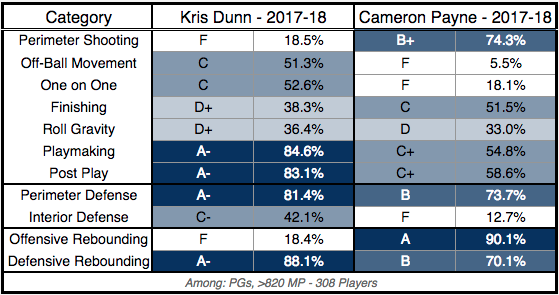
Meanwhile, despite playing only 304 minutes last year, Arcidiacono did enough to match Dunn’s proficiency defending the perimeter. Both finished with identical A- grades last season. The newly-acquired Ulis is currently the second-best playmaking point guard on the roster. His 4.4 assists per game in 71 appearances with the Phoenix Suns last season play a part is his B+ in that category. Dunn and Ulis also move off-the-ball equally well, holding identical C grades.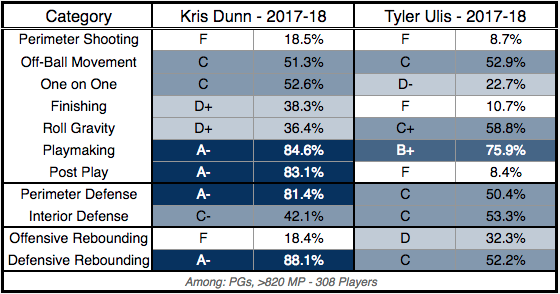
Kris Dunn has grown tremendously as a player during his short time in Chicago. He showed throughout the preseason that he deserves his current starting role. However, the three backups behind him are just as young, have almost as much potential, and are able to deliver in other parts of the game that Dunn has not yet developed. Dunn is the best current all-around player, but the Bulls can look to their backup options to provide some of what Dunn brings, each in their own ways.
Wings: Can They Do More Than Score?
The Bulls’ wings are never shy about shooting the ball. Just this preseason, Zach LaVine, Justin Holiday, and Antonio Blakeney averaged the third-, fourth-, and fifth-most field goal attempts per game, respectively. Denzel Valentine has been out with a left ankle injury; but he, too, will shoot at will once he returns.
It’s good that the wings are enthusiastic about generating offense for the team. However, the bigger separator moving forward will likely be the level of consistently performance on the defensive end. Putting up shots is great, but can you also make the stop on the other end?
When compared with other wings that played at least 820 minutes, Denzel Valentine (71st percentile) graded out as the best perimeter defender in the unit, but was only a negligible amount better in the category than LaVine (69th percentile). Both finished with a B in the category. Holiday graded out to a C+, but had an A- as an interior-defending wing. Blakeney’s lack of playing time aided in his D-grade on the perimeter and D+ inside.
The Bulls finished 28th in the NBA in defensive rating last year. It’ll be quite a climb to be an average defensive unit, but their wings have the defensive talent to help that pursuit. The Chicago wings as a unit grade out as the 8th most talented perimeter defensive squad. However, they’re just 18th on the defensive end as a unit. Investment into growth and playing as a cohesive unit may help the tables turn to help the Bulls’ wings look past just being scorers and begin performing on the other end as well.
Stretch Forwards: Could This Be Any More Awkward?
The arrangement seemed simple. Jabari Parker would come in on a two-year, $40 million deal and start at small forward. Rising star Lauri Markkanen would continue to start at power forward with Bobby Portis to back him up. Portis even stated that he was very game to come off the bench.
Bobby Portis, embracing his inner Taj Gibson, on 6th man role: "I like the role. I get to come off the bench and score a lot. Who doesn’t like to score the ball? That’s a fun gig."
— K.C. Johnson (@KCJHoop) September 25, 2018
Markkanen’s right elbow injury and Jabari Parker’s shaky preseason has since put a wrench in those plans. Now, Portis seems on track to be the starting 4 for the season opener Thursday against the Philadelphia 76ers. Parker could be the one playing the bench role.
This arrangement has a chance to actually work out short-term. Hoiberg just needs one of them to produce when he starts the game and the other to keep the energy going when he enters off the bench. As we’ve seen from his preseason lineup changes, he doesn’t exactly care who gets which job done.
However, things are going to get awkward again once Markkanen returns, presumably in December. With Parker’s time at small forward proving unsuccessful in the preseason, we now have a log-jam at the power forward position. How will Hoiberg handle this situation? Will he give Parker another shot at the 3? Does he make Portis a backup center? This will likely be one of the most fluid roster situations this season.
Centers: Has the Future Already Arrived?
There was plenty of positive buzz when Wendell Carter, Jr. was drafted seventh overall in the 2018 NBA Draft. Following a promising Summer League (14.6 points, 9.4 rebounds per game), it was fair to wonder how soon it would be before he was ready to become a starter.
That time may be sooner than you think. Carter averaged 7.0 points, 5.6 rebounds, and 2.2 assists per game during the preseason. Those numbers aren’t huge, but they blow away the output of fellow centers Robin Lopez (2.0 points, 3.0 rebounds per game) and Cristiano Felicio (1.6 points, 2.6 rebounds per game).
The crux of the issue comes from the fact that Carter’s game is different from the other centers on the roster. Lopez, Felicio, and the indefinitely-sidelined Omer Asik are all considered “parasitic bigs” in the style based offensive role data BBall Index calculated from Nylon Calculus’ Todd Whitehead’s initial calculations. Basically, they are rolling and cutting bigs that take very few dribbles per touch and are assisted on almost all of their shots.
Carter, on the other hand, is much more than that. As a rookie, he doesn’t have any stats with which to assign an offensive role yet. However, we see that he is more capable than his counterparts of creating scoring opportunities for himself. During the preseason, 80.0 percent of Lopez’s shots and all of Felicio’s were assisted. By comparison, 66.7 percent of Carter’s shots were assisted. Carter can also create for others: his 11 total assists in five preseason games was more than twice as many as what Lopez and Felicio doled out combined (5).
Quite simply, Wendell Carter brings a welcome change of pace to the center position. He certainly isn’t an All-Star-caliber player yet, but he is good enough to be a stable starter while possessing the tools to develop into something more. As long as he stays healthy, this may be the one position the organization won’t have to worry about this year.
It’s Year 2 after the Jimmy Butler trade, so it’s hard to consider this a “make or break” year. However, this is a season where the vision for the future could become a lot clearer. The Chicago Bulls come into 2018-19 with a lot of question marks regarding their roster. The grind of the season will ultimately determine which players could be here for the long haul and which are passing through.
Header image by Akshay Ram

